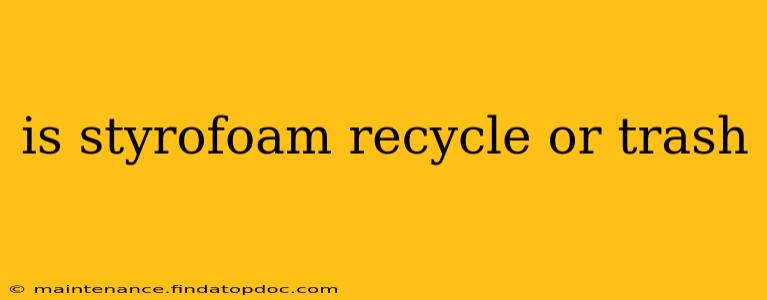Styrofoam, that ubiquitous lightweight plastic, often leaves consumers wondering: is it recyclable or trash? The simple answer is: it depends. While technically recyclable, the widespread availability of recycling programs for Styrofoam (polystyrene) is sadly limited. This guide will delve into the complexities surrounding Styrofoam recycling, offering solutions and highlighting the environmental impact of improper disposal.
Where Can I Recycle Styrofoam?
This is the most frequently asked question. Unfortunately, there's no single answer. Most curbside recycling programs do not accept Styrofoam. The reason is twofold:
-
Processing Challenges: Styrofoam is bulky and takes up significant space in recycling facilities. It also requires specialized equipment and processes to recycle effectively, which many facilities lack.
-
Contamination Concerns: Styrofoam is easily contaminated by other materials. Even a small amount of food residue can render a whole batch of Styrofoam unrecyclable.
To find Styrofoam recycling options near you, you need to take a proactive approach:
- Check with your local recycling center: Contact your local waste management company or recycling center directly. They can provide specific information about their accepted materials.
- Search online for "Styrofoam recycling near me": This will often reveal local businesses or initiatives that accept Styrofoam for recycling.
- Look for drop-off locations: Some retailers, such as packaging stores or specific grocery chains, might have partnerships with recycling programs for Styrofoam.
- Consider specialized recycling programs: Some companies specialize in polystyrene recycling and will either accept shipments directly or partner with drop-off locations in your area.
Is it Possible to Recycle Styrofoam at Home?
Home recycling of Styrofoam is generally not feasible. The processes involved require specialized equipment and safety precautions. Attempting to recycle it at home might even be dangerous.
What Happens to Styrofoam in a Landfill?
Styrofoam remains in landfills for an incredibly long time – hundreds, even thousands of years – without breaking down. This contributes significantly to landfill space limitations and environmental pollution.
What are the Environmental Impacts of Styrofoam?
Beyond landfill issues, Styrofoam production and disposal contribute to various environmental problems:
- Fossil Fuel Consumption: Styrofoam's production relies heavily on fossil fuels, contributing to greenhouse gas emissions.
- Pollution: Improper disposal leads to land and water pollution, harming wildlife and ecosystems.
- Microplastic Contamination: Styrofoam breaks down into microplastics, which contaminate soil and water sources.
What are the Alternatives to Styrofoam?
Conscious consumers are increasingly seeking alternatives to Styrofoam due to its environmental impact. Several eco-friendly options exist:
- Biodegradable packaging: Made from plant-based materials like bamboo or sugarcane bagasse, these options decompose naturally.
- Reusable containers: Investing in reusable food containers and storage solutions can significantly reduce reliance on disposable Styrofoam.
- Recycled paperboard: This sustainable material is readily recyclable and offers a comparable level of protection.
Can I Recycle Expanded Polystyrene (EPS) and Extruded Polystyrene (XPS)?
Yes, both Expanded Polystyrene (EPS – the common white Styrofoam) and Extruded Polystyrene (XPS – a denser type often used in insulation) can be recycled, though the processes and acceptance vary. Contact your local recycling center or search for specialized recycling programs to confirm your options.
How Can I Reduce My Styrofoam Consumption?
The most effective approach to addressing the Styrofoam problem lies in reducing consumption. Here are some practical steps:
- Choose reusable alternatives: Opt for reusable containers, bags, and cups instead of relying on disposable Styrofoam products.
- Buy products with minimal packaging: Support businesses that prioritize sustainable packaging practices.
- Advocate for change: Contact your local representatives and advocate for policies that promote Styrofoam recycling and responsible waste management.
By understanding the complexities of Styrofoam recycling and adopting responsible consumption habits, we can minimize its negative environmental impact. Remember to always check with your local waste management services for specific guidelines and recycling options in your area.
